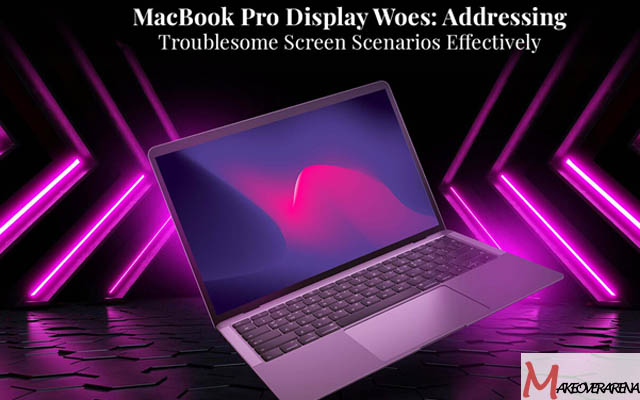MacBook Pro Display Woes. Hey there, MacBook enthusiasts! Today, let’s dive into the intriguing world of MacBook Pro displays and tackle those pesky screen issues head-on. We’ve all been there – whether it’s a flickering screen, mysterious glitches, or just a stubborn black void staring back at you.

Fear not! In this guide, we’ll be your digital troubleshooters, exploring effective ways to address these display woes and bring your MacBook Pro back to its radiant, glitch-free glory. So, hang tight as we unravel the mysteries of those troublesome screen scenarios together.
The Flickering Fiasco
The infamous flickering screen – a true test of one’s patience. The display on your MacBook Pro laptop is exhibiting an intermittent flashing anomaly indicating either a hardware or software malfunction.
Initial troubleshooting steps of inspecting display interconnect cables for proper seating and adjusting backlight parameters have proven ineffective. Additional recommended corrective measures include updating to the latest macOS release to resolve any potential firmware or driver-related bugs, as well as performing a System Management Controller reset to reinitialize low-level device functions. Further system diagnostics may be required should the visual distortion persist.
Ghosting or Image Retention
Image retention, sometimes referred to as “ghosting,” is a common issue that impacts older MacBook Pro models with Retina displays. This phenomenon causes remnants of previous windows and images to linger on the screen, creating a digital “haunting” effect. While disconcerting, this is simply a technical glitch.
To banish these lingering spectres, you can display a solid blank color on the MacBook screen for an extended period. Alternatively, allow your laptop’s screensaver to run for a long period.
Besides, specialized apps exist to cycle screens through various colors, effectively wiping away stubborn retinal burn-in issues. If image retention persists despite these efforts, further support may be required.
Black Screen of Death
Alright, so you’re in the groove, watching a movie or typing away, and then it happens – your MacBook screen turns black. Panic mode engaged, right? Well, this problem can be caused by various factors such as system glitches, overheating, battery issues, hardware failures, or screen damage.
However, before you start running the helter-skelter, first check the power and brightness level of your laptop. You can also force restart your Mac, as restarting a device often fixes temporary glitches.
If the issue persists, try resetting the Systems Management Controller and your NVRAM/PRAM. Likewise, reinstall your MacOS or boot your MacBook in Safe mode.
Dead Pixels
Discovering a dead pixel on a MacBook Pro can elicit feelings of disappointment similar to finding an imperfection on a brand new vehicle. These defective pixels fail to illuminate properly, instead displaying as black, white or colored dots on the screen contrary to the surrounding imagery. Dead pixels cannot respond accurately to electrical signals, leading to interrupted visual output.
Though disheartening, dead pixels are not necessarily a lost cause. While resuscitating deal pixels proves exceptionally difficult, experts advise that gently massaging areas containing stuck pixels on a MacBook Pro display may help revive function.
This physical manipulation is believed to stimulate the screen’s liquid crystal elements at the microscopic level, potentially unsticking the defective pixels. Additionally, specialized software exists expressly for rectifying stuck pixel issues. By rapidly cycling through a series of colors, these applications create a strobe-like effect that essentially shocks the pixels back to responsiveness.
If all fails, Apple’s warranty or AppleCare might come to the rescue. Dead pixels are often covered under these plans, so don’t hesitate to reach out for professional assistance.
Unresponsive Display
A MacBook Pro with a display that refuses to wake up from its slumber can be a perplexing experience. Before spiraling into panic mode, check the basics. Ensure your MacBook is charged, as a drained battery can lead to unresponsiveness.
If that doesn’t do the trick, try resetting the NVRAM (Non-Volatile Random Access Memory) or PRAM (Parameter RAM). These stores hold various settings, and sometimes a reset can kick the display back into action.
Should the issue persist, it might be time to explore the hardware realm. Inspect the display cable for any signs of damage and, if comfortable, reseat it. However, if the display remains stubbornly unresponsive, it’s advisable to seek professional help.
Conclusion
As we navigate the intricate landscape of MacBook Pro display woes, one thing becomes abundantly clear – every glitch, flicker, or blackout is a puzzle waiting to be solved. Addressing troublesome screen scenarios effectively isn’t just about technical prowess; it’s a journey of exploration, patience, and resourcefulness.
Whether it’s battling the notorious flickering screen, banishing ghostly remnants, or deciphering the mystery behind a sudden blackout, MacBook Pro users find themselves armed with a toolkit of troubleshooting techniques.
As we bid adieu to this exploration, may your MacBook Pro screens stay vibrant, resilient, and always ready for the next chapter in the dynamic world of technology. Happy troubleshooting!
CHECK THESE OUT:



